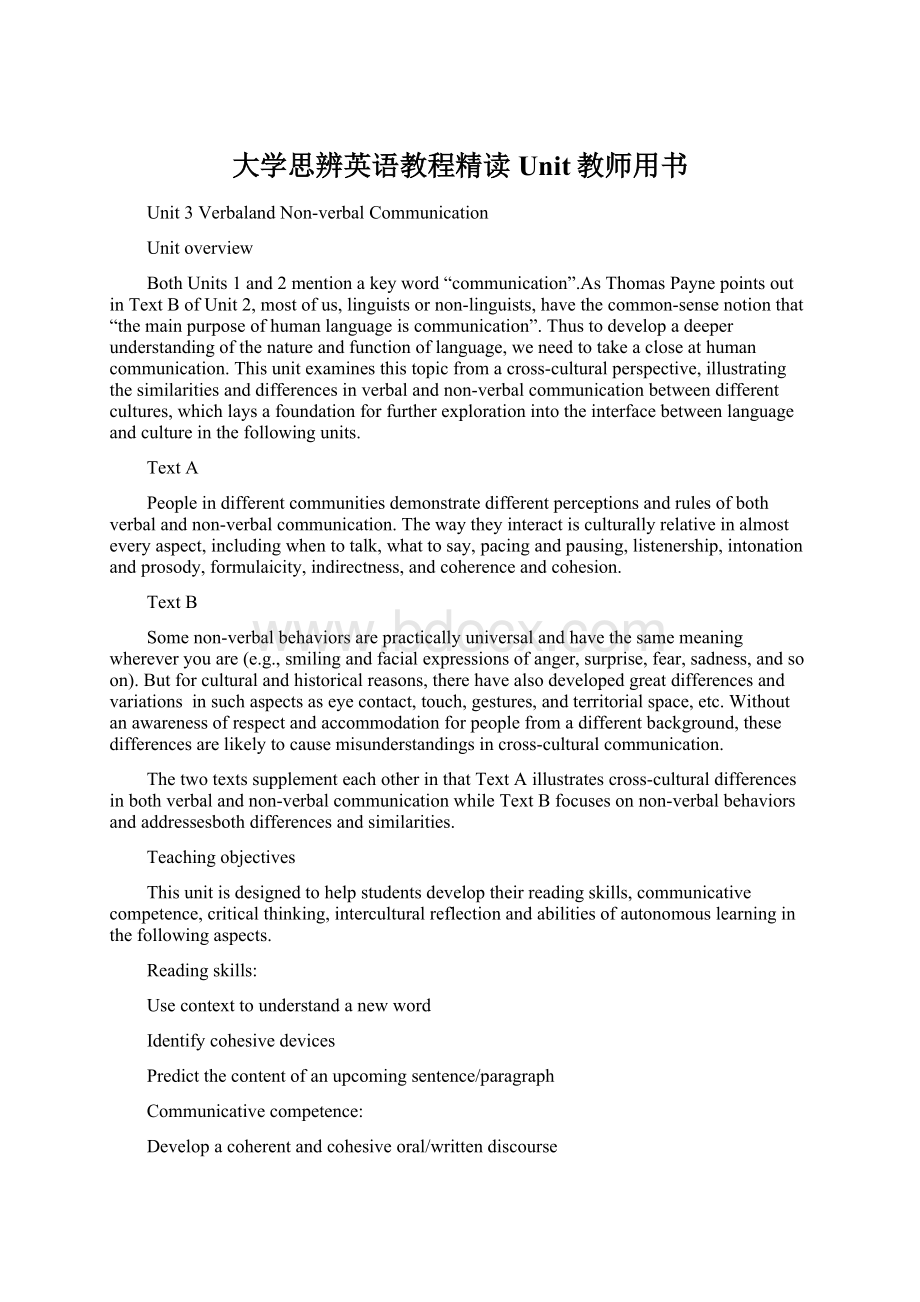大学思辨英语教程精读Unit教师用书.docx
《大学思辨英语教程精读Unit教师用书.docx》由会员分享,可在线阅读,更多相关《大学思辨英语教程精读Unit教师用书.docx(9页珍藏版)》请在冰豆网上搜索。

大学思辨英语教程精读Unit教师用书
Unit3VerbalandNon-verbalCommunication
Unitoverview
BothUnits1and2mentionakeyword“communication”.AsThomasPaynepointsoutinTextBofUnit2,mostofus,linguistsornon-linguists,havethecommon-sensenotionthat“themainpurposeofhumanlanguageiscommunication”.Thustodevelopadeeperunderstandingofthenatureandfunctionoflanguage,weneedtotakeacloseathumancommunication.Thisunitexaminesthistopicfromacross-culturalperspective,illustratingthesimilaritiesanddifferencesinverbalandnon-verbalcommunicationbetweendifferentcultures,whichlaysafoundationforfurtherexplorationintotheinterfacebetweenlanguageandcultureinthefollowingunits.
TextA
Peopleindifferentcommunitiesdemonstratedifferentperceptionsandrulesofbothverbalandnon-verbalcommunication.Thewaytheyinteractisculturallyrelativeinalmosteveryaspect,includingwhentotalk,whattosay,pacingandpausing,listenership,intonationandprosody,formulaicity,indirectness,andcoherenceandcohesion.
TextB
Somenon-verbalbehaviorsarepracticallyuniversalandhavethesamemeaningwhereveryouare(e.g.,smilingandfacialexpressionsofanger,surprise,fear,sadness,andsoon).Butforculturalandhistoricalreasons,therehavealsodevelopedgreatdifferencesandvariationsinsuchaspectsaseyecontact,touch,gestures,andterritorialspace,etc.Withoutanawarenessofrespectandaccommodationforpeoplefromadifferentbackground,thesedifferencesarelikelytocausemisunderstandingsincross-culturalcommunication.
ThetwotextssupplementeachotherinthatTextAillustratescross-culturaldifferencesinbothverbalandnon-verbalcommunicationwhileTextBfocusesonnon-verbalbehaviorsandaddressesbothdifferencesandsimilarities.
Teachingobjectives
Thisunitisdesignedtohelpstudentsdeveloptheirreadingskills,communicativecompetence,criticalthinking,interculturalreflectionandabilitiesofautonomouslearninginthefollowingaspects.
Readingskills:
Usecontexttounderstandanewword
Identifycohesivedevices
Predictthecontentofanupcomingsentence/paragraph
Communicativecompetence:
Developacoherentandcohesiveoral/writtendiscourse
Usetopicsentences,supportingsentencesandconcludingsentencesinpresentations/essays
Communicateconstructivelyinteamwork
Criticalthinking:
Evaluatethestrengthsandweaknessesofpersonalexperienceasevidenceinargumentation
Organizetheargumentsusinganoutline
Noteandreflectonthedifferencesbetweenacademicwritingandeverydaywriting
Interculturalreflection
Identifysimilaritiesanddifferencesinnon-verbalcommunicationacrosscultures
Beawareofmultiplelevelsofdifferencesonwhichcross-culturalcommunicationcanfalter
Interpretcommunicationbehaviorsfromculturalandhistoricalperspectives
Teachingstrategies
Non-verbalcommunicationandcross-culturalcommunicationarebothinterestingtopicsinlinguistics.Theteachercanintroducethetwotextsbyquotinganecdotesorrelatingtostudents’ownexperiences(question5inPreparatorywork,p.59).Forstudentswholackexperienceofcross-culturalcommunication,thetopiccanbeledinbydiscussionsaboutinter-subculturalcommunication.
TextAisaresearcharticlefromanacademicjournalanditsstructureandwritingstylearequiteclear.Itisrecommendedtodrawstudents’attentiontotheauthor’slogic(i.e.,waysofarguing)anduseofevidenceinclass.Ifwell-planned,allthequestionsinPreparatoryWorkandCriticalreadingcanbedealtwithinsomedetailinclass.TheteachercanfollowallthequestionsinUnderstandingthetexttocheckstudents’comprehensionofthetext,whilethetasksinEvaluationandexplorationcanbedividedandassignedtogroups.Forexample,inMakinganoutline(p.62),theteachercandividethestudentsintothreegroups,eachresponsibleforonetopic.
Forclassicalworksininterculturalcommunication,pleasereferto:
Hall,EdwardT.(1955).TheAnthropologyofManners.ScientificAmerican,192:
85-89.
Hall,EdwardT.(1959).TheSilentLanguage.NewYork:
Doubleday.
Formoreupdatedinformation,pleasefindthefollowingjournals:
Cross-CulturalCommunicationpublishedbyCanadianAcademyofOrientalandOccidentalCulture(CAOOC)
AcrossLanguagesandCulturespublishedbyAkadémiaiKiadó
LanguageandInterculturalCommunicationpublishedbyRoutledgeJournals,Taylor&FrancisLtd.
Preparatorywork
(1)Academicinterests:
genderandlanguage,interactionalsociolinguistics,conversationalinteraction,cross-culturalcommunication,framestheory,conversationalvs.literarydiscourse,andnewmediadiscourse.
(2)
Mainpublications:
YouJustDon'tUnderstand:
WomenandMeninConversation.NewYork:
Morrow,1990.
That'sNotWhatIMeant!
:
HowConversationalStyleMakesorBreaksRelationships.NY:
WilliamMorrow,1986.
GenderandDiscourse.NY&Oxford:
OxfordUniversityPress,1994.
Note:
OutsidetheacademicworldDeborahTannenisbestknownastheauthorof?
anumberofbooksontheNewYorkTimesbestsellerandshe?
isalsoafrequentguestontelevisionandradionewsandinformationshows.
(3)EdwardSapir(1884–1939):
an?
American?
anthropologistwhoiswidelyregardedasoneofthemostimportantfiguresintheearlydevelopmentofmodernlinguistics.Hismaininterestsareinthewaysinwhichlanguageandcultureinfluenceeachother,therelationbetweenlinguisticdifferences,anddifferencesinculturalworldviews.Hismostimportantcontributioniswhatisknownastheprincipleof?
linguisticrelativity?
orthe"Sapir-Whorf"hypothesis.
(4)
JohnJosephGumperz(1922–2013):
anAmericanlinguist.HisresearchinterestsincludethelanguagesofIndia,code-switching,andconversationalinteraction.Well-knownforhiscontributionininteractionalsociolinguisticsandthe"ethnographyofcommunication",Gumperz’sresearchhasbenefittedsuchfieldsassociolinguistics,discourseanalysis,andlinguisticanthropology.
E.M.Forster(1879–1970):
anEnglishnovelist,shortstorywriter,essayistandlibrettist.Heisknownbestforhisironicandwell-plottednovelsexaminingclassdifferenceandhypocrisyinearly20th-centuryBritishsociety.HewasnominatedfortheNobelPrizeinLiteraturein13differentyears.
RobertKaplan:
AnAmerican?
appliedlinguist.Hisresearchareacoversappliedlinguistics,discourseanalysis,languagepolicy,languageplanning,andESL/EFLTeaching.HeismostfamousforhiscontributioninContrastiveRhetoric,atermhefirstcoinedin1966.Kaplanhasauthoredoredited32books,morethan130articlesinscholarlyjournalsandchaptersinbooks,andmorethan85bookreviewsandotherephemeralpiecesinvariousnewsletters,aswellas9specialreportstotheU.S.governmentandtogovernmentselsewhere.
(5)Pragmaticsisthesystematicstudyofmeaningdependentonlanguageinuse.Unlikesemantics,whichexaminesconventionalmeaning"coded"inagivenlanguage,pragmaticsstudieshowthetransmissionofmeaningdependsnotonlyonstructuralandlinguisticknowledge(e.g.,grammar,lexicon,etc.)ofthespeakerandthehearer,butalsoonthecontextoftheutterance,anypre-existingknowledgeaboutthoseparticipantsinvolved,theinferredintentofthespeaker,andotherfactors.Centraltopicsofpragmaticsincludeaspeaker’scommunicativeintentions,theuseoflanguagethatrequiressuchintentions,contextofuse,therelationbetweentheuserofalinguisticformandtheactofusingtheform,andthestrategiesanaddresseeemploystoworkoutwhattheintentionsandactsare.
(6)
(7)Cohesionreferstotheuseofvariousphonological,grammatical,and/orlexicalmeanstolinksentencesorutterancesintoawell-connected,largerlinguisticunitsuchasaparagraphorachapter.Inotherwords,cohesionachieveswell-connectednessbymeansoflinguisticforms.
(8)
Example:
Maryisasecretary.Sheworksinalawfirm.Yan(2012)
Coherencereferstothelogicalwell-connectednessbetweendifferentpartsofapieceofspokenorwrittenlanguage,whichdistinguishesitfromarandomassemblageofsentencesorutterances.Yan(2012)
Formly?
incohesive?
discourse?
may?
be?
coherent?
through?
common?
sense,?
cultural?
background,?
contextual?
information,?
imagination,?
logical?
assumption,?
etc.?
Husband:
?
That’s?
the?
telephone.?
Wife:
?
I’m?
in?
the?
bath.?
Husband:
?
OK.?
(9)Pauseisatemporaryandbriefbreakintheflowofspeech,whichisoftenclassifiedintofilledpauseandunfilledorsilentpause.Theformeristakenuporfilledbyahesitationformlikeah,er,andum.Incontrast,thelatterisnotfilledbyahesitationform.Inotherwords,asilentpauseisonewherethereisnovocalization.
(10)
Criticalreading
I.Understandingthetext
(1)Themainpurposeofthisarticleistoillustrateeightlevelsofcross-culturaldifferencesinnon-verbalaspectsofcommunication.
(2)Wecanunderstandthenatureoflanguagebyobservingitincommunicationandincontactwithothersystemsofcommunication.
(3)Pacingandpausing,listenership.Indecidingwhentotalkandwhattosay,thespeakerusuallytakesaconsciousspeechplanning,yetinpacingandpausingandinshowinglistenershipinaconversation,onedoesnotneedtostopandthinkforadecision.
(4)Section2.1startswithadirectthesisstatement.Thentheauthorexplainsitwithanexpert’s(Scollon)researchfindingsandexamples.Insection2.2theauthorraisesanumberofquestions(inpara7,9and11)andrespondstothemwithrelevantresearchfindings(Goody’saswellashers)andherownpersonalexperience.Section2.3isalsoorganizedintheorderof“question-answer”.Section2.4illustratescross-culturaldifferenc